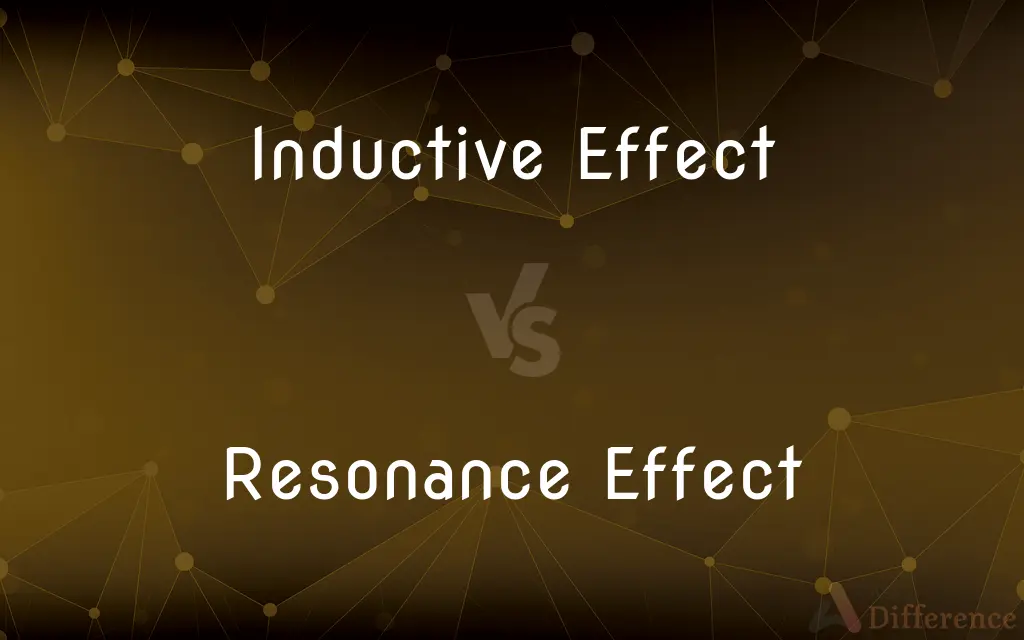Inductive Effect vs. Resonance Effect — What's the Difference?
By Tayyaba Rehman — Published on January 5, 2024
Inductive effect involves electron donation or withdrawal through sigma bonds due to electronegativity differences, while resonance effect involves electron delocalization over pi bonds in conjugated systems.

Difference Between Inductive Effect and Resonance Effect
Table of Contents
ADVERTISEMENT
Key Differences
The inductive effect refers to the electron-shifting influence exerted by atoms through single covalent (sigma) bonds due to differences in electronegativity. This effect, which can be either electron-withdrawing or electron-donating, is a permanent feature of molecular structure. In contrast, the resonance effect involves the delocalization of electrons across adjacent pi bonds or lone pairs in a molecule, creating multiple contributing structures that are a blend of all possible resonance forms.
Inductive effect typically diminishes with distance from the atom causing the effect, as it operates through bonds rather than across space. Conversely, the resonance effect is not limited by distance in the same way, as it depends on the extended pi electron system. The resonance effect can enhance the stability of a molecule by spreading out electron density, while the inductive effect simply shifts electron density along the chain.
In terms of reactivity, the inductive effect can make a molecule more polar, affecting its physical properties and reactivity in chemical reactions. The resonance effect, however, often defines the molecule’s chemical behavior, especially in aromatic systems, influencing acidity, basicity, and reactivity.
While the inductive effect is a localized phenomenon affecting only parts of a molecule, resonance effect requires a conjugated system and can influence the entire molecule. Understanding both effects is crucial for predicting the behavior of organic molecules in chemical reactions.
Comparison Chart
Nature
Electron donation or withdrawal through sigma bonds.
Electron delocalization over pi bonds.
ADVERTISEMENT
Dependency
Electronegativity differences.
Conjugation in the molecule.
Range
Decreases with distance from the source.
Can be extended throughout a conjugated system.
Chemical Influence
Affects molecule polarity and local reactivity.
Affects overall stability and reactivity of a molecule.
Structural Requirement
No specific structural requirement other than polar covalent bonds.
Requires a conjugated system with alternate double and single bonds or lone pairs.
Compare with Definitions
Inductive Effect
It's a permanent effect present in sigma-bonded structures.
Alkyl groups exert an electron-donating inductive effect.
Resonance Effect
It is responsible for the distribution of electron density over several atoms.
The resonance effect disperses the negative charge in carboxylate ions.
Inductive Effect
Inductive effect influences the acidity and basicity of molecules.
Due to the inductive effect, chloroacetic acid is more acidic than acetic acid.
Resonance Effect
Resonance effect contributes to the stabilization of charged intermediates.
Resonance effect stabilizes the carbocation in allylic systems.
Inductive Effect
It can either be electron-withdrawing or electron-donating.
Fluorine exerts a strong electron-withdrawing inductive effect.
Resonance Effect
Resonance effect is a key concept in understanding aromaticity.
Aromatic compounds exhibit resonance effect, which accounts for their unique reactivity.
Inductive Effect
The inductive effect is crucial for understanding molecular reactivity.
The inductive effect helps explain the reactivity of substituted benzenes.
Resonance Effect
It can significantly alter the electronic nature of molecules.
The nitro group’s resonance effect makes it a powerful electron-withdrawing group.
Inductive Effect
Inductive effect is the polarization of electron density along a chain due to electronegativity differences.
The inductive effect causes the C-Cl bond to be polarized.
Resonance Effect
Resonance effect describes electron delocalization in molecules with conjugated systems.
Benzene is stable due to the resonance effect.
Common Curiosities
Why is the resonance effect important in chemistry?
It explains the stability and reactivity of many organic compounds, especially aromatic compounds.
Does the inductive effect operate in saturated or unsaturated compounds?
It can operate in both but is most often discussed in relation to saturated compounds.
How does the inductive effect influence chemical reactions?
It can increase or decrease the reactivity of a molecule by affecting electron density.
What does the resonance effect describe?
The delocalization of electrons across a system of connected p-orbitals in a molecule.
What is the inductive effect?
It's the shifting of electrons in a molecule due to the electronegativity of atoms through sigma bonds.
Is the inductive effect the same as hyperconjugation?
No, hyperconjugation is related but involves delocalization of electrons in sigma bonds to adjacent pi systems or empty orbitals.
Can the inductive effect stabilize ions?
Yes, especially if the ion is stabilized by electron-donating or withdrawing groups via the inductive effect.
Are inductive and resonance effects mutually exclusive?
No, they can both influence a molecule’s properties simultaneously.
Is resonance the same as mesomerism?
Yes, mesomerism is another term for the resonance effect, particularly in European literature.
Does the inductive effect affect bond lengths?
Indirectly, as it can lead to partial charges that influence bond characteristics.
Does temperature affect the inductive or resonance effect?
Generally, these electronic effects are not significantly affected by temperature.
Can the resonance effect be observed in all organic compounds?
No, only in those with conjugated systems capable of electron delocalization.
Does the resonance effect result in the formation of resonance structures?
Yes, resonance structures are different Lewis structures that represent the same molecule and show electron delocalization.
How are inductive and resonance effects taught in organic chemistry?
They are fundamental concepts taught to explain molecular structure, stability, and reactivity.
How does the resonance effect impact acid strength?
It can stabilize conjugate bases through delocalization, thereby enhancing acid strength.
Share Your Discovery

Previous Comparison
Solution vs. Solvent
Next Comparison
Semaphore in OS vs. Monitor in OSAuthor Spotlight
Written by
Tayyaba RehmanTayyaba Rehman is a distinguished writer, currently serving as a primary contributor to askdifference.com. As a researcher in semantics and etymology, Tayyaba's passion for the complexity of languages and their distinctions has found a perfect home on the platform. Tayyaba delves into the intricacies of language, distinguishing between commonly confused words and phrases, thereby providing clarity for readers worldwide.













































